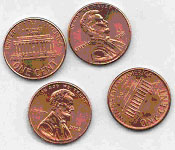
(See related pages)
| The Investigation poses questions to generate interest in various
mathematical topics from the text and encourages students to formulate
and investigate their own conjectures. One use of the investigations is
for term papers in which students report on their conjectures and the
patterns they find. Click on the Read Me file below to open the investigation in a Word file: The Math Investigator is a data collection software program that may be used to collect data for the investigation. You may type answers onto the Word file or copy and paste in data from the Investigator. Click here to launch the Coin Toss InvestigatorMath Investigator 8.1COIN TOSS SIMULATION on the Math Investigator simulates the toss of a coin up to 100 times and prints the sequence of heads and tails. The computer prints the empirical probability of obtaining a given number of heads or a number of consecutive heads.  Starting Points for Investigations
a. Use Coin Toss Simulation and at least 30 repetitive trials to determine the empirical probabilities for each of the following events: tossing a coin 4 times and obtaining exactly 2 heads; tossing a coin 6 times and obtaining exactly 3 heads; tossing a coin 8 times and obtaining exactly 4 heads; etc. b. Based on your observations from part a, write a conjecture about the probabilities of obtaining exactly 50% heads for larger and larger even numbers of tosses. Check your conjecture for some large even numbers and document whether or not your conjecture appears to be true. a. Determine the empirical probabilities for the following events: obtaining at least 1 head in a toss of 2 coins; at least 2 heads in a toss of 4 coins; and at least 3 heads in a toss of 6 coins. b. Use your data from part a to predict what will happen to the probabilities of obtaining at least 50% heads for larger and larger even numbers of tosses. Check your predictions for some large even numbers. a. What is the empirical probability of tossing a coin 5 times and obtaining at least 3 consecutive heads? b. What is the empirical probability of tossing a coin 6 times and obtaining at least 3 consecutive heads? c. Experiment with different numbers of tosses to determine the number so that the probability of tossing at least 3 consecutive heads is 50%. Based on your data, what is this number of tosses? |